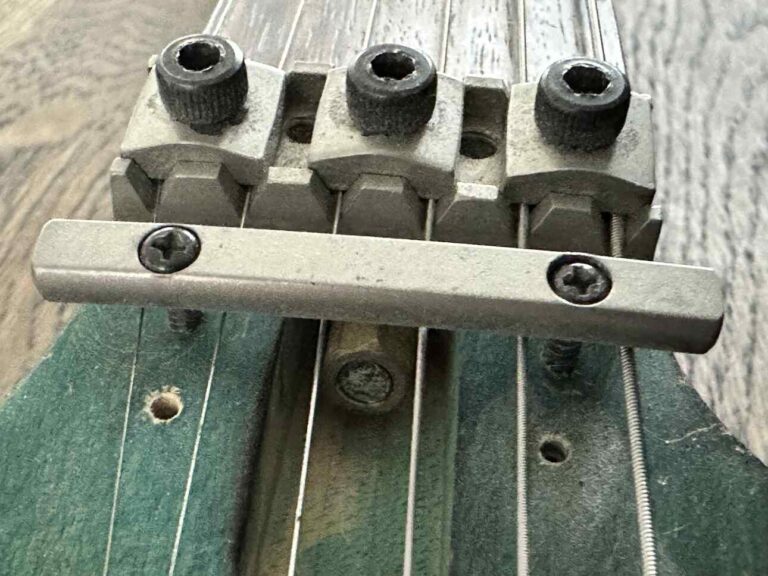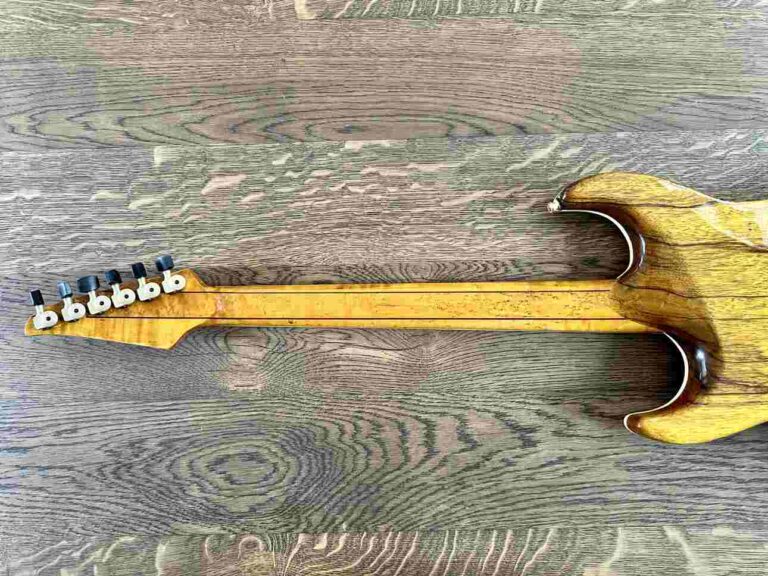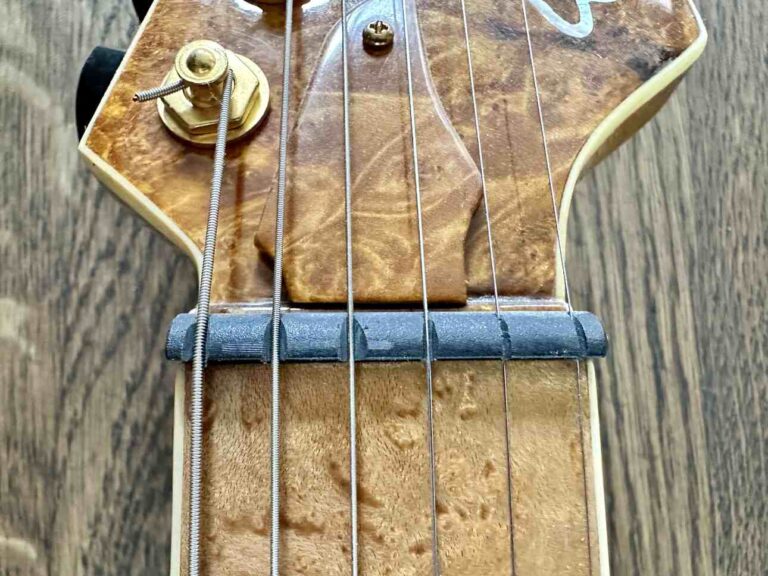How Much String Tension Can a Guitar Neck Take?
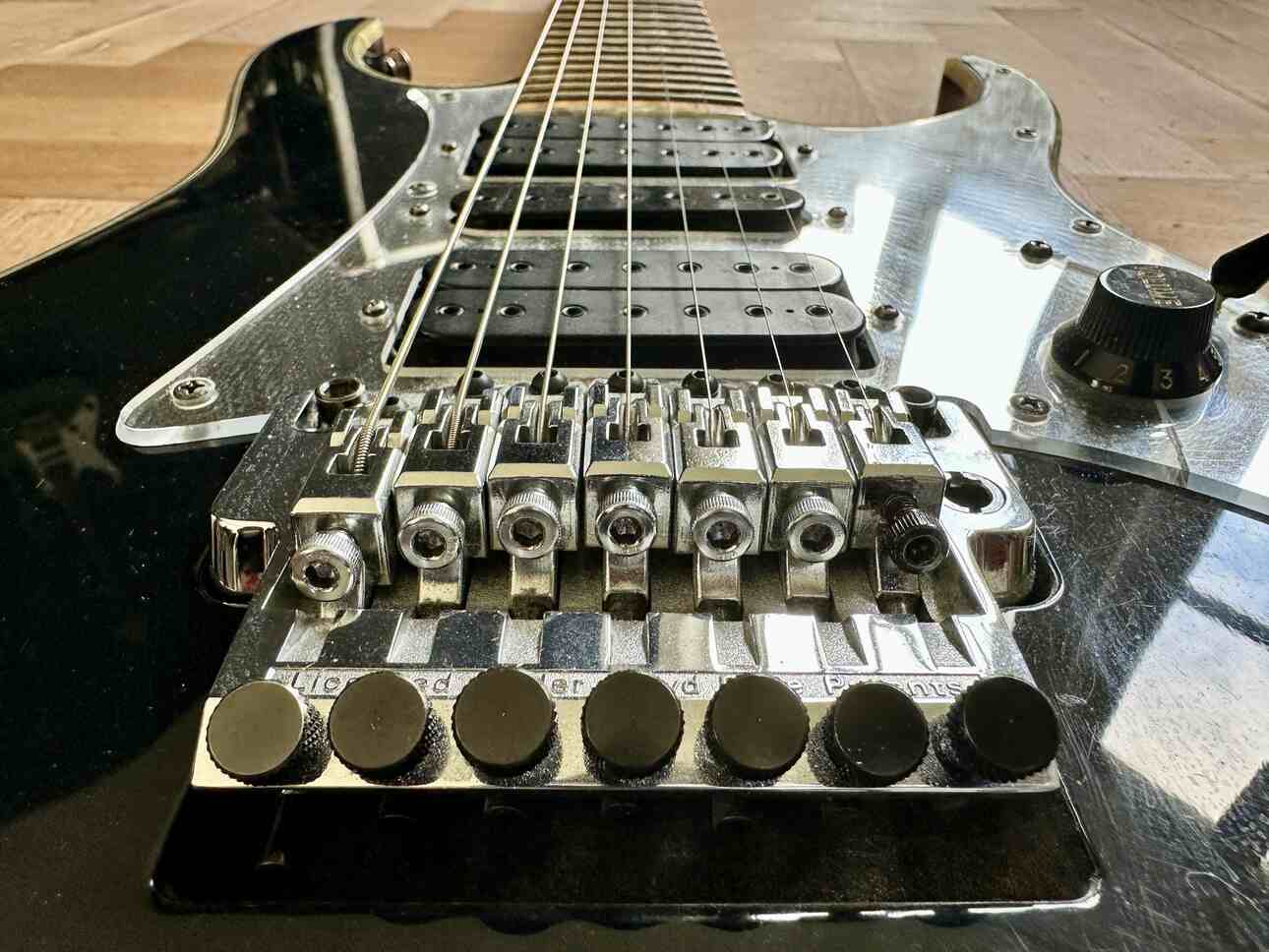
When tuned properly, guitar strings put a certain amount of pressure on the neck. Most guitar necks can handle between 100 to 150 pounds of tension from regular strings. This pressure can change a bit depending on the type of strings and the specific guitar model.
The neck of your guitar, whether electric or acoustic, is built to withstand this force. But, excessive tension from heavier gauge strings or improper tuning can cause stress and potential damage over time.
So, it’s good to know a thing or two about this subject. Below, you’ll find everything you need to know about string tension.
Let’s dive in!
Key Takeaways
- Most guitar necks can handle 100-150 pounds of tension;
- Regular checks and proper tuning maintain neck health;
- Choosing appropriate strings is essential for longevity.
Fundamentals of String Tension
Defining String Tension
String tension refers to the force that stretches the guitar strings. This tension determines the pitch and feel of the strings.
When you pluck a string, the tension between the nut and bridge defines how the string vibrates. High tension means tighter strings and a higher pitch, while lower tension results in looser strings and a lower pitch.
Even small changes in tuning can significantly affect the tension.
Gauge and Tension Relationship
String gauge, which is the thickness of the string, has a direct impact on string tension.
Thicker strings (higher gauge) need more tension to reach a pitch than thinner strings (lower gauge).
This means that switching from light to heavy gauge strings will increase the tension of the strings.
Lighter gauge strings reduce tension and make bending and fretting easier. But they might produce less volume or sustain.

How Strings Generate Tension
Strings generate tension when they are tightened between the guitar’s bridge and the nut.
The string’s material, such as steel or nylon, affects how much tension can be applied before the string breaks.
The tuning process creates the necessary tension for the strings to produce sound.
When tuning, you adjust the pegs to increase or decrease the tension until the string reaches the desired pitch.
The tension can be affected by environmental conditions like temperature and humidity. It can cause the strings to expand or contract, impacting their tautness.
Anatomy of a Guitar Neck
Understanding Neck Construction
The neck is usually made from maple, mahogany, or rosewood. These woods are chosen for their strength and ability to produce good tone.
The shape of the neck can vary; common shapes include C-shape, V-shape, and U-shape. The neck must be strong enough to withstand the tension from the strings.
The Role of the Truss Rod
The truss rod is a metal rod that runs inside the neck. It is essential for adjusting the neck’s curvature or ‘relief.’
Without it, the neck might bend under the tension of the strings, affecting playability and sound.
A properly adjusted truss rod ensures the neck remains straight and stable.
Adjusting the truss rod can fix fret buzz, which occurs when the strings hit the frets, creating an unwanted buzzing sound.
You can adjust it by inserting a wrench into the nut at the end of the truss rod. In acoustic guitars, it is often found near the headstock or inside the body near the soundhole.
Properly adjusting your truss rod is crucial for maintaining good action. It also impacts how easy or hard it is to play the guitar.
Tuning and Tension
Effects of Tuning on Tension
Different tuning methods can significantly change your guitar strings and neck tension.
Standard tuning places a specific amount of tension on the strings. But alternate tunings, such as Dropped-D Tuning, can increase or decrease this tension.
For example, tuning down to Dropped-D reduces the tension on the thickest string. This makes it easier to press down.
On the flip side, tuning up can add stress, potentially causing the neck to bow or even warp.
Adjust your guitar’s truss rod when you change tunings to balance the tension.

Finding the Right String Gauge
Choosing the right string gauge depends on your guitar and playing style.
Thicker strings produce a richer, fuller sound but add more tension to the guitar neck. Thinner strings create less tension but may produce a lighter tone.
Longer necks allow for lower tunings without the strings becoming too slack.
Experiment with different gauges to find what works best for you.
For example, if you often play in lower tunings, you might prefer heavier strings to keep the tension optimal.
Calculating String Tension
To understand the limits of a guitar neck, you need to know how to calculate string tension. Various factors, like the type of string and the length of the guitar neck, play a role in this calculation.
Using a String Tension Calculator
A string tension calculator is a valuable tool. It helps you estimate the force exerted by the strings.
You input details like string gauge, scale length, and tuning.
For instance, a medium-gauge string tuned to E on a guitar with a 25.5-inch scale length generates a certain tension.
Here’s a simple equation often used:
[ T = (UW \times (2 \times L \times F)^2) ]
Where:
- T is tension
- UW is unit weight
- L is scale length
- F is frequency
Using online calculators makes the process quicker and minimizes errors.
Factors Influencing Calculations
Several factors influence string tension calculations.
- String gauge: Thicker strings exert more tension;
- Scale length: Longer necks increase tension for the same pitch;
- Tuning: Higher pitches need higher tension;
- Material of the strings: Steel typically generates more tension than nylon.
Calculating string tension accurately ensures that you don’t exceed the limits of your guitar neck.
Proper calculation helps maintain the guitar’s playability and longevity without causing damage.
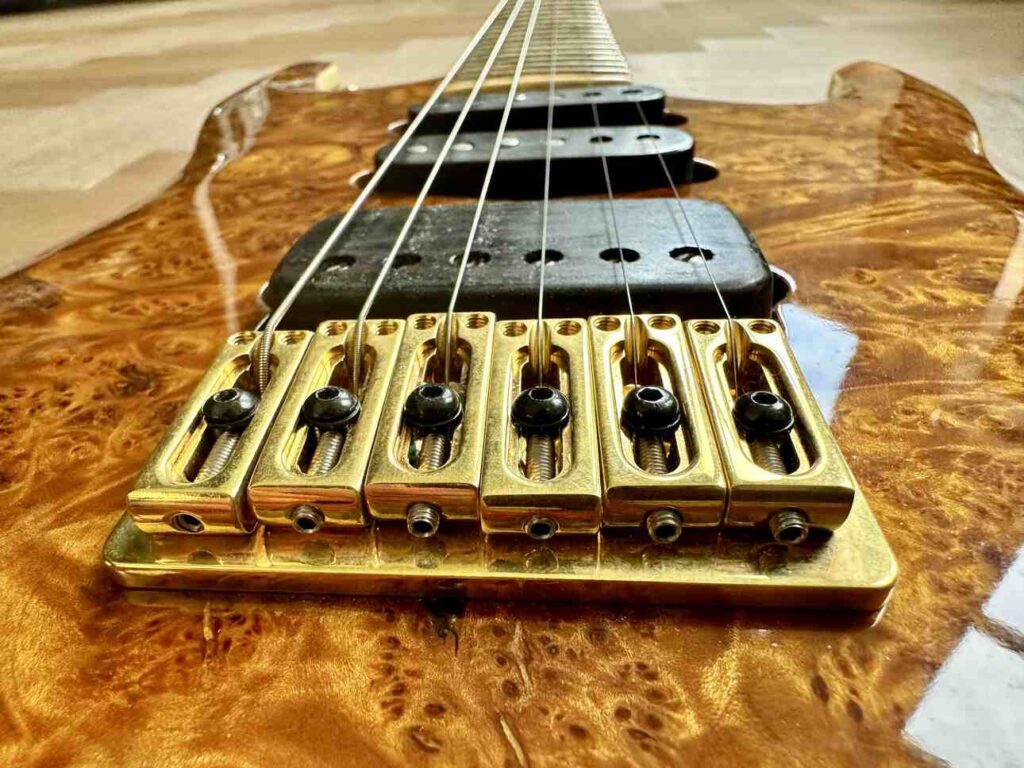
Impact of Tension on the Guitar Neck
Guitar neck tension is critical for maintaining your instrument’s sound and playability. The guitar strings put a certain amount of force on the neck, which can affect its structure.
Amount of Force Exerted by Strings
The tension on a guitar’s neck comes from the strings. A standard set of strings can put around 100 pounds of force on the neck, depending on the gauge and tuning.
Heavier gauge strings can increase this force. It potentially stresses the neck.
Always consider the string gauge and your guitar type to avoid excessive tension. It might warp or bow the neck.
Signs of Excessive Neck Tension
Excessive neck tension can show up in several ways. One common sign is a bowed or warped neck. This can lead to higher action, making the guitar harder to play.
Buzzing strings are another indicator. The strings may not clear the frets properly when the neck bends too much.
You might also notice a change in tuning stability. The neck’s deformation can cause frequent tuning issues.
Check for cracks around the neck joint or fretboard, which can result from too much tension.
Using a high gauge set of strings increases tension a lot.
Inspect the neck and adjust the truss rod if needed. This can prevent long-term damage and ensure your guitar remains playable.
Choosing the Right Strings for Your Guitar
Strings for Different Guitar Types
Each guitar type requires specific strings to produce the best sound and feel. Electric guitars often use lighter gauge steel strings. They are easier to bend and play fast.
Meanwhile, acoustic guitars usually have heavier gauge steel strings. They provide a richer, louder sound.
Finally, classical guitars use nylon strings. They provide a warmer tone and are easier on the fingers.
Bass guitars need even heavier gauge strings to handle lower frequencies. Using the wrong string type can make playing difficult and affect your guitar’s neck tension.
Always choose strings suited for your guitar type.
Balanced Tension Across the Neck
Balanced tension means that each string feels similar when you press down or bend it. Playing can be uncomfortable and uneven if one string has much higher tension.
This is important for comfort and preventing long-term damage to your guitar neck.
Using wound strings for bass notes and non-wound strings for higher notes helps balance the tension.
You can choose brands like Kalium Strings. They offer sets designed for balanced tension. This prevents any one part of the neck from taking too much stress, keeping your guitar in good shape.
Customizing String Sets
Standard string sets might not fit your playing style. The good news is that you can customize your string sets. This means mixing and matching strings from different sets. You can even swap individual strings to get the right feel and sound.
For example, if you play a lot of lead guitar, you might prefer lighter treble strings for easy bending and heavier bass strings for solid rhythms.
Customizing can also help you achieve a unique sound, whether aiming for a classic rock tone or something more experimental.
Creating a custom set takes some trial and error, but the effort can perfectly match your style and instrument.
You can mix and match strings from different sets. You can even swap individual strings to get the right feel and sound
Maintaining Neck Health
Regular Inspection and Adjustments
It’s important to check your guitar neck regularly for stress or damage. Check for cracks, warping, or unusual bends.
The truss rod is inside your guitar neck. It helps adjust the neck relief and the slight curve your neck needs to handle string tension.
To adjust the truss rod, use the appropriate wrench (usually an Allen key) to turn the rod.
Tightening the rod reduces neck relief, meaning less curve. Loosening it increases neck relief.
Always make small adjustments and retune the guitar after each turn. This ensures you don’t over-tighten or loosen the rod too much.
Monitoring the neck relief helps maintain proper intonation. It also keeps your guitar sounding great.
When to Seek Professional Help
Sometimes, inspecting and adjusting the neck may not be enough. If you notice persistent issues like buzzing strings or if the neck seems unusually warped, it’s best to consult a professional.
A luthier can accurately gauge tension-related problems and provide the necessary repairs.
If you are unsure about adjusting the truss rod, check with a professional. Improper handling can cause more damage to the guitar neck. This will affect your instrument’s playability and sound.
Also, a pro can help reset the neck to its ideal state. This is especially valuable if your guitar experiences changes in temperature or humidity. It keeps your guitar in the best shape and extends its lifespan.
Frequently Asked Questions
How much tension can a guitar neck handle safely?
A standard guitar neck can typically handle 100 to 150 pounds of tension. The exact range is dependent on the guitar model and the neck material.
What sets the limit to the guitar neck elasticity?
Many factors influence how much tension a guitar neck can handle. These include wood type, neck construction, and whether it is reinforced with a truss rod. These construction details distinguish the products with regard to their strength.
What does string gauge do to your guitar neck?
Thicker strings give off more tension. For instance, thicker gauge strings can increase tension by several extra pounds the neck has to hold up under. Knowing how playing with a string gauge affects your guitar is important.
How do I determine the tension of the string coming from my guitar?
You can use calculators to calculate the tension based on string gauge, scale length, tuning, etc. They ensure you don’t exceed the safe limits of your guitar.
Is it bad to tighten my guitar strings too heavily and stretch them hard?
Neck warping, fret buzz, or even snapping the neck can all be problems resulting from over-tightening your guitar strings. To avoid experiencing the issues, you mustn’t push the tension beyond the limits.

